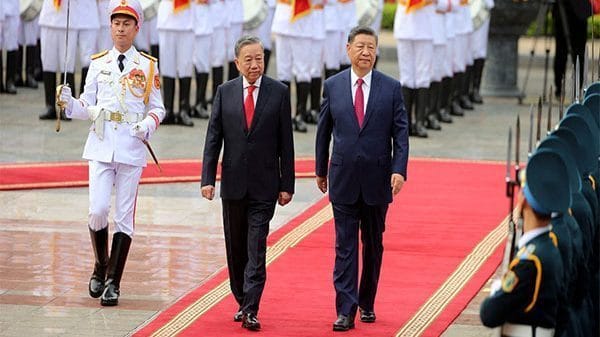“Friendship, sincerity and inclusiveness” and “to build a community with a shared future for mankind, we must first start from Asia”—these are some of the headline themes featured in the Chinese media coverage of President Xi Jinping’s ongoing visit to Southeast Asia. Far from a routine diplomatic trip, the visit, scheduled from 14 to 18 April, is framed in Chinese discourse as both a reaffirmation of regional ties and a strategic move to consolidate influence in its immediate neighbourhood.
The emphasis on “friendship and camaraderie” with Vietnam, Malaysia, and Cambodia underscores China’s push to present itself as a stable, long-term partner and regional anchor. The narrative being projected is one of natural proximity, economic complementarity, and shared stability.
Weibo posts reflect this sentiment, with one stating: “Vietnam, Malaysia, and Thailand maintain ties with the United States, but if they had to choose, they would stand with China.” While anecdotal, such views echo a core assumption in Chinese discourse—that geographic closeness and entrenched economic links place China in a more legitimate leadership role than extra-regional powers.
Xi’s visit, then, is not merely a response to shifting US policies, such as Donald Trump’s tariffs, but part of a broader, long-term strategy. For China, it is a reminder that leadership in its periphery is not only natural—it is enduring.
Neighbours before distant relatives
The concept of zhoubian waijiao (peripheral diplomacy) remains a cornerstone of Chinese foreign policy. Southeast Asia is seen not only as geopolitically vital, but as a space to refine and showcase China’s model of regional governance. Xi’s visit, in this framing, reaffirms the value China places on neighbourhood ties, particularly in a period of global uncertainty.
Jin Canrong, a professor at Renmin University, evoked an old Chinese proverb, “Distant relatives are not as close as neighbours”, to explain the priority placed on immediate neighbours. He argues that amid weakening multilateral institutions and intensifying China-US competition, closer ties with neighbours provide both insulation and leverage. In his view, each stop on Xi’s trip served a strategic purpose: Vietnam, as both political and economic parallel; Cambodia, as a loyal partner with high-profile joint ventures like the Ream Naval Base and Funan Techo Canal; and Malaysia, as the 2025 ASEAN chair, instrumental for pushing regional integration aligned with Chinese priorities.
Economic messaging has also featured prominently. A trending hashtag—“China and ASEAN’s trade complementarity continues to strengthen”—dominated coverage of the Chinese President’s trip. The underlying message is clear: ASEAN and China are each other’s largest trading partners, and this mutual reliance is seen as the foundation of long-term cooperation.
Peng Bo, a research fellow at the Chinese Ministry of Commerce’s research institute, argues that US tariffs are nudging Southeast Asia further into China’s economic orbit. Vietnam, for instance, is deeply embedded in supply chains that rely on Chinese inputs, making closer integration with China a practical necessity for the country. In this context, China’s consistency and openness are contrasted with what is often portrayed as the West’s conditional or coercive alternatives.
Zhang Yunling, a member of the faculty of the Chinese Academy of Social Sciences, situates Xi’s regional diplomacy within a broader pattern. He contends that while global consensus is increasingly elusive, regionalism still offers viable paths for cooperation. ASEAN, in Chinese commentary, is praised for its flexibility and inclusiveness—traits that conveniently align with Beijing’s vision of multipolar engagement.
Also read: China-US trade war has parallels with Japan in WW2. Will it escalate to military conflict?
Managing optics, masking tensions
A closer reading of Chinese discourse reveals a sanitised, selective narrative. While the economic and diplomatic themes are amplified, contentious issues—most notably the South China Sea—are conspicuously absent. This omission is not incidental. It reflects a deliberate strategy to portray harmony, sidestep friction, and reinforce the image of China as a benevolent regional power.
By visiting countries seen as more amenable to Beijing, Xi’s itinerary helps sustain the illusion of a unified Southeast Asia leaning toward China. Yet this tightly managed narrative—where everything appears hunky-dory—masks underlying tensions. The strategic avoidance of sensitive issues may preserve short-term diplomatic optics, but it raises questions about the sustainability of this approach.
In reality, ASEAN remains divided on how to engage with China. Beijing’s selective engagement only sharpens these fault lines, exacerbating divisions within the grouping. While China’s messaging promotes a vision of unity and mutual benefit, its actual diplomacy often entrenches fragmentation, a trend that is only fostering long-term regional instability.
This disconnect is not lost on Southeast Asian governments, many of which are increasingly hedging. Even as they deepen economic ties with China, they are simultaneously strengthening relationships with India, Japan, and Australia, and even trying to find ways to deal with Trump’s tariffs. Far from a region rallying behind Chinese leadership, Southeast Asia appears more cautious, and more fragmented, than Beijing’s discourse suggests.
Sana Hashmi is a fellow at the Taiwan-Asia Exchange Foundation. She tweets @sanahashmi1. Views are personal.
(Edited by Aamaan Alam Khan)






